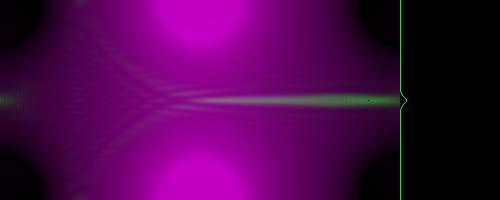
The following figures and video graphically depict how an electrostatic field might be arranged to focus the quantum mechanical probability wave packet of a moving charged particle.
In the video and in Figure 1, the small green blob on the left is the wave packet of a proton. There are attractive negative charges at the four corners of the screen (blacker indicates more negative potential) and the purple splotches at top and bottom center are positive charges. The maximum positive and negative potentials are +70 and -70 electron volts (eV), respectively. The potential fields drop off inversely with distance (1/r) from the 70 eV "plateaus". The proton has a kinetic energy of 80 electron volts, so classically could travel right over the barriers. The green line to the right, with what appears to be a notch in the center, is a probability histogram. It shows the probability of finding the proton at each point along the vertical axis (but it could be anywhere along the horizontal axis).
Click here to start an MPEG movie that shows the time evolution of the proton's probability wave packet. As you can see, the wave packet spreads out as it travels along - a process that one must come to expect from quantum mechanics!

Figure 1: The Initial State

Figure 2: The Final State